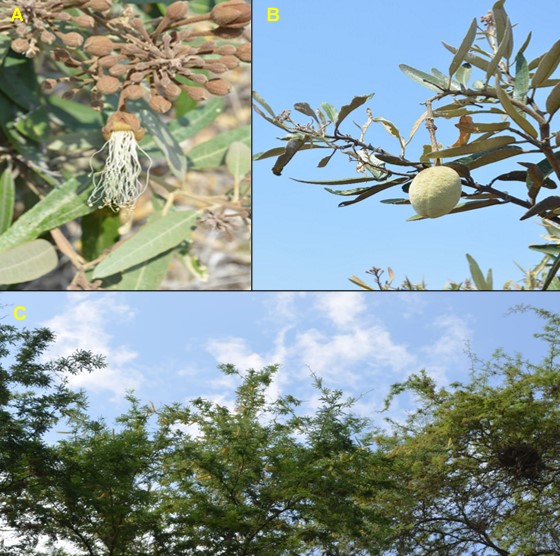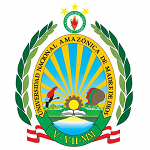Status of the populations of carob trees (Neltuma-Fabaceae) in the Historical Sanctuary of the Pomac Forest
DOI:
https://doi.org/10.55873/gentryana.v2i2.301Keywords:
Peruvian coast, diversity, sapoteAbstract
In the Peruvian coast, algarrobo and zapote trees were once vital to the ecosystem and the development of ancient Peruvian cultures. Today, they are severely impacted. This study evaluated the populations of algarrobo and associated species in the Pomac Forest Historic Sanctuary (SHBP) to assess the current status of the algarrobo forests. A total of 21 plots were analyzed: 18 temporary plots and 3 permanent plots (1 algarrobo, 2 mixed zapote) of 1 hectare each. Population structure and composition, phenology, and health conditions were assessed. The results indicate that the structure of algarrobo and mixed zapote forests is similar, with a predominance of young and adult individuals with diameters at breast height (DBH) of 15-25 cm and average heights of 15 m. Neltuma pallida is the most abundant species, making up over 80% of the total population. The entire algarrobo tree population shows mild to moderate impacts, with 50-75% of individuals exhibiting moderate impact (e.g., trunks with pathogen attack signs), and over 90% of individuals having dead or dry branches. Furthermore, 40% of the population shows moderate to severe damage. Regarding natural regeneration, seedlings and saplings in the 21 plots represent less than 5% of the adult population. We conclude that the algarrobo populations and associated species in the SHBP are experiencing severe impacts, particularly due to low levels of natural regeneration, indicating that the degradation of these populations is worsening over time.
References
AGCG. (2017). Memoria Anual, Santuario Histórico Bosque de Pómac.
Capparelli, A., & Prates, L. (2015). Explotación de frutos de algarrobo (Prosopis spp.) por grupos cazadores recolectores del noreste de Patagonia. Chungará (Arica). https://doi.org/10.4067/s0717-73562015005000030
CONAFOR. (2011). Manual y procedimientos para el muestreo de campo re-muestreo 2011. Inventario Nacional Forestal y de Suelos. Inventario Nacional Forestal y de Suelos.
Cuentas, R. M., Salazar, T., & Ítalo, A. (2017). De la especie al ecosistema; del ecosistema a la sociedad: Revalorizando el algarrobo (Neltuma pallida) y el reto de su conservación en Lambayeque y en la costa norte del Perú. Espacio y Desarrollo. https://doi.org/10.18800/espacioydesarrollo.201702.006
Cuba-Córdova, Z., Loayza-Vargas, D., & Huamantupa-Chuquimaco, I. (2023). Diversidad, estructura y estado sanitario de las poblaciones de los bosques de huarangales en el valle de Ica, sur peruano. Revista Gentryana, 2(1), 46–61. https://revistas.unamad.edu.pe/index.php/
FAO. (2004). Inventario Forestal Nacional, Manual de Campo Modelo. Informe. Programa de Evaluación de los Recursos Forestales, 89.
Fernández, A., & Rodríguez, E. (2007). Etnobotánica del Perú prehispánico.
Leal-Pinedo, J. M., & Linares-Palomino, R. (2005). Los bosques secos de la Reserva de Biósfera del Noroeste (Perú): Diversidad arbórea y estado de conservación. Caldasia, 27(2), 195–211.
MINAGRI. (2013). Proyecto Inventario Nacional Forestal y Manejo Forestal Sostenible del Perú ante el Cambio Climático: Datos de campo del muestreo forestal en las ecozonas hidromórfica y de tierra firme (Loreto) y en zona costera (Piura y Lambayeque). Lima: MINAM.
MINAM. (2015a). Guía de inventario de la flora y vegetación.
MINAM. (2015b). Mapa nacional de cobertura vegetal: Memoria descriptiva.
Phillips, O., Baker, T., Feldpausch, T., & Brienen, R. (2016). Manual de campo para el establecimiento y la remedición de parcelas.
Rodríguez, E. F. R., Bussmann, R. W., & Alfaro, S. J. A. (2007). Capparis scabrida (Capparaceae): Una especie del Perú y Ecuador en urgente necesidad de planes de conservación. America.
SENASA. (2015). Situación fitosanitaria del algarrobo (Neltuma pallida) en la costa norte del Perú.
SERNANP-SHBP. (2013). Plan de manejo de recursos naturales renovables: Recurso forestal Neltuma pallida "Algarrobo" en la Zona de Uso Especial.
SERNANP-SHBP. (2015). Estrategia para el aprovechamiento de recursos naturales renovables en el SHBP. Lambayeque, Perú.
SERNANP-SHBP. (2016). Informe anual de aprovechamiento del recurso fruto seco de sapote (Capparis scabrida) en la Zona de Uso Especial del Santuario Histórico Bosque de Pómac - 2016.
SERNANP-SHBP. (2017). Plan maestro del Centro Histórico de Lima (al 2029 con visión al 2035). Publicado en Internet https://aplicativos.munlima.gob.pe/extranet/plan-maestro/
SERNANP-SHBP. (2018). Memoria Anual 2017.
Vásquez, L., Escurra, J., & Huamán, A. (2010). Los algarrobos del Perú. Chiclayo.
Weberbauer, A. (1945). El mundo vegetal de los Andes peruanos (E. E. A. de L. M. Ministerio de Agricultura, Dirección de Agricultura, Ed.). Lima, Perú.

Downloads
Published
How to Cite
Issue
Section
License
Copyright (c) 2024 Miguel Luza-Victorio, Isau Huamantupa-Chuquimaco, Sirley Bernabé-Orellano, Jacqueline Ramírez-Chávez, Yaneth Quispe-Mamani, Henry Paolo Villegas-Ogoña, Zoila Magaly Cuba-Córdova

This work is licensed under a Creative Commons Attribution 4.0 International License.
The authors, knowing that the GENTRYANA journal has an Open Access policy (Open Access) accept the conditions of the Creative Commons Attribution 4.0 International LICENSE (CC BY 4.0).







